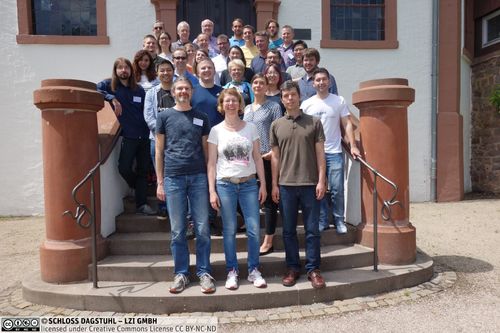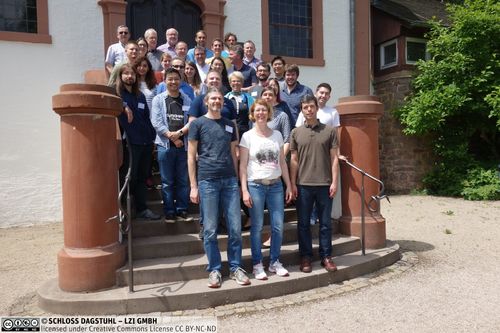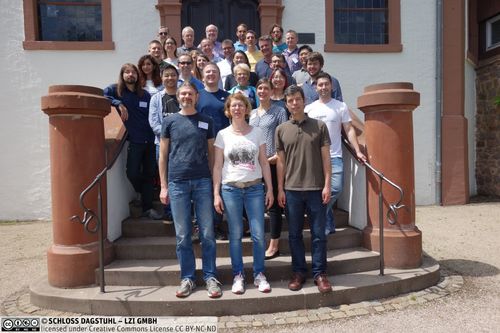Dagstuhl-Seminar 16262
Automotive User Interfaces in the Age of Automation
( 26. Jun – 01. Jul, 2016 )
Permalink
Organisatoren
- Susanne Boll (Universität Oldenburg, DE)
- Andrew L. Kun (University of New Hampshire - Durham, US)
- Andreas Riener (TH Ingolstadt, DE)
Kontakt
- Annette Beyer (für administrative Fragen)
Impacts
- 1st Workshop on Ethically Inspired User Interfaces for Automated Driving : article in Proceedings : AutomotiveUI '16 Adjunct Adjunct Proceedings of the 8th International Conference on Automotive User Interfaces and Interactive Vehicular Applications - Riener, Andreas; Jeon, Myounghoon; Alvarez, Ignacio; Pfleging, Bastian; Mirnig, Alexander; Chuang, Lewis L.; Tscheligi, Manfred - New York : ACM, 2016. - pp. 217-220.
- 1st Workshop on Situational Awareness in Semi-Automated Vehicles : article in Adjunct Proceedings of the 8th International Conference on Automotive User Interfaces and Interactive Vehicular Applications (AutomotiveUI ’16) - MacCall, Rod; Baumann, Martin; Politis, Ioannis; Sadeghian Borojeni, Shadan; Alvarez, Ignacio; Terken, Jacques; Chuang, Lewis L.; Tscheligi, Manfred; Meschtscherjakov, Alexander; Mirnig, Alexander - New York : ACM, 2016. - pp. 233-236.
- 1st Workshop on Understanding Automation : Interfaces that Facilitate User Understanding of Vehicle Automation : article in Adjunct Proceedings of the 9th International ACM Conference on Automotive User Interfaces and Interactive Vehicular Applications (AutomotiveUI ’17) - New York : ACM, 2017. - 8 pp. - New York : ACM, 2017. - 8 pp. - Chuang, Lewis L.; Boll, Susanne; Manstetten, Dietrich; Baumann, Martin.
- A Hidden Markov Frameblock to Capture Human–Machine Interaction in Automated Vehicles : article - Janssen, Christian P.; Boyle, Linda Ng; Kun, Andrew L.; Ju, Wendy; Chuang, Lewis L. - London : Taylor & Francis, 2019. - 9 pp - (International Journal of Human–Computer Interaction ; 2019).
- Assisting Drivers with Ambient Take-Over Requests in Highly Automated Driving : article in Proceedings of the 8th International Conference on Automotive User Interfaces and Interactive Vehicular Applications (AutomotiveUI ’16) - Sadeghian Borojeni, Shadan; Chuang, Lewis L.; Heuten, Wilko; Boll, Susanne - New York : ACM, 2016. - pp. 237-244.
- Developing a Highly Automated Driving Scenario to Investigate User Intervention : When Things Go Wrong : article in Adjunct Proceedings of the 9th International ACM Conference on Automotive User Interfaces and Interactive Vehicular Applications (AutomotiveUI ’17) - Faltaous, Sarah; Baumann, Martin; Machulla, Tonja; Chuang, Lewis L. - New York : ACM, 2017. - 5 pp..
- Towards a Personalized Trust Model for Highly Automated Driving : article : In: Weyers, B. & Dittmar, A. (Hrsg.), Mensch und Computer 2016 : 6 pp. - Wintersberger, Philipp; Frison, Anna-Katharina; Riener, Andreas; Boyle, Linda Ng - Bonn : Gesellschaft für Informatik e.V., 2016.
- Towards Adaptive Ambient In-Vehicle Displays and Interactions : Insights and Design Guidelines from the 2015 AutomotiveUI Dedicated Workshop : Chapter in "Automotive User Interfaces, Gerrit Meixner, Christian Müller" 978-3-319-49447-0 - Löcken, Andreas; Sadeghian Borojeni, Shadan; Gable, Thomas M.; Triberti, Stefano; Diels, Cyriel; Glatz, Christiane; Boll, Susanne; Chuang, Lewis L.; Alvarez, Ignacio; Müller, Heiko - Berlin : Springer, 2017. - pp. 325-348.
- Towards Life-Long Mobility : Accessible Transportation with Automation : article in Adjunct Proceedings of the 8th International Conference on Automotive User Interfaces and Interactive Vehicular Applications (Automotive UI ’16), October; 24 - 26, 2016, Ann Arbor, MI, US. : pp. 201-206 - Jeon, Myounghoon; Politis, Ioannis; Shladover, Steven E.; Sutter, Christine; Terken, Jacques; Poppinga, Benjamin - New York : ACM, 2016.
- Trust in Technology as a Safety Aspect in Highly Automated Driving : article : pp. 297-310 - Wintersberger, Philipp; Riener, Andreas - München : Oldenbourg, 2016 - (i-com : 15. 2016,3).
- Tutorial on Design and Evaluation Methods for Attention Directing Cues : article in Adjunct Proceedings of the 8th International Conference on Automotive User Interfaces and Interactive Vehicular, Applications (AutomotiveUI ’16) - Sadeghian Borojeni, Shadan; Chuang, Lewis L.; Löcken, Andreas; Glatz, Christiane; Boll, Susanne - New York : ACM, 2016. - pp. 213-215.
The next big change in the automotive domain will be the move towards semi-automated and automated driving. The pathway to autonomous driving supported by rapid advance of a wide range of novel vehicle-related technology presents industry, academia, and regulatory agencies with new opportunities and challenges in re-imagining human interactions in the vehicle. While expectations are high towards automated driving the revolution will proceed in incremental steps; with the progress of technology new tasks and driving phases will be supported by automation. All of this will unfold in traffic scenarios in which different levels of automation will coexist for many years in which user interfaces play a key role.
We see three core challenges for automotive user interfaces in the age of automation, which we want to address during the seminar.
- Productivity and play in the car: With advancing levels of automation, driver and also passengers will have more time and attention for non-driving tasks. Thus, we will be able to more freely explore a range of possible interactions: manual, visual, auditory, and tactile. For coming years we need to explore interfaces and applications that make driving safe while enabling communication, work, and play in human-operated vehicles. Novel user interfaces may turn the car into an infotainment and entertainment platform in which the automation allows for new secondary tasks in the car with driver and passengers that were not possible before.
- Engagement and re-engagement of drivers into the driving task: While automation will allow us to disengage from driving, we need to develop methods to re-engage in driving. As interruptions may vary in time but also the engagement of the user in a second task, it will be a challenge to safely and timely return to the primary task. Much work needs to be done on user interface design in order to make re-engagement in different kind of situations and different kind of complexity work and safe.
- Collaboration in mixed traffic scenarios: Traffic automation will come to the streets gradually and mixed scenarios with vehicles with no, partial, and full automation will coexist in daily traffic for many years. This involves, amongst others, communicating autonomous operations to the driver of the autonomous car and also communication strategies to keep non-autonomous vehicles, their drivers, as well as other (vulnerable) road users in the loop.
Along with these topics we will also discuss the role of trust, e.g., how user interfaces will support the communication of trust in typical situations with mixed levels of automation. We will further discuss about future technologies in and around the car (e.g., novel sensors and feedback systems) and about the recent strategy change of automakers to fund apps and invest a lot in app development to make car dashboards/instrument clusters more sustainable.
This Dagstuhl Seminar will bring together researchers from human computer interaction, cognitive psychology, human factors, psychology, and also from automotive industry and OEMs to discuss the new interface paradigms for (semi)automated driving. One of the core outcomes will be a research agenda for in vehicle user interfaces moving towards different levels of automation in mixed traffic scenarios.
The next big change in the automotive domain will be the move towards semi-automated and automated driving. The pathway to autonomous driving supported by rapid advance of a wide range of novel vehicle-related technology presents industry, academia, and regulatory agencies with new opportunities and challenges in re-imagining human interactions in the vehicle. While expectations are high towards automated driving the revolution will proceed in incremental steps; with the progress of technology new tasks and driving phases will be supported by automation. All of this will unfold in traffic scenarios in which different levels of automation will coexist for many years in which user interfaces play a key role.
We see three core challenges for automotive user interfaces in the age of automation, which we have addressed during the seminar.
- Transforming vehicles into places of productivity and play. People in automated vehicles will be able to turn their attention to non-driving tasks some of the time, or even much of the time. This will allow user interface designers to explore a range of possible interactions, which are might be too distracting in manually driven vehicles. For highly automated vehicles our constraints will have to do less with the driver’s attention to the road, and more with the characteristics of the vehicle, such as the area available for interaction, the motion of the vehicle, as well as its computational power and the sensors that are available in the cockpit. User interactions will include other people in the vehicle, but might also include people in other vehicles. Novel user interfaces may turn the car into an infotainment and entertainment platform in which the automation allows for new secondary tasks in the car with driver and passengers that were not possible before.
- Re-engagement of drivers into the driving task. As automated driving makes advances, drivers will often be able to disengage from driving, and safely turn their attention to a secondary task. But until our vehicles are fully automated, drivers will eventually have to re-engage in driving. As the non-driving tasks may vary in time but also in the engagement of the user, it will be a challenge to safely and timely return to the primary task. For handling a critical situation the driver must perceive, and act upon, a sequence of information and entities. This can be a complex maneuver in a traffic scenario but also a time critical course of actions in the treatment of an emergency case. Much work needs to be done on user interface design in order to make re-engagement in different kinds of situations and different kinds of complexity safe.
- Collaboration in mixed traffic scenarios. Traffic automation will come to the streets peu-a-peu. Thereby and for many years, mixed scenarios in which vehicles with no-, partial-, and full automation will coexist and cooperate in daily traffic. This road sharing involves communicating autonomous operations to the driver of the autonomous car and also a communication strategy to keep non-autonomous vehicles and their drivers in the loop. Road sharing means avoiding collisions, but automated vehicles will also cooperate, for example by traveling in platoons in order to save energy and improve the utilization of the road infrastructure. Research is needed to create user interfaces that allow for safe operation of the vehicle in all of these mixed traffic scenarios.
Along with these topics, we also discussed the role of trust, e.g., how user interfaces will support the communication of trust in typical situations with mixed levels of automation. We further discussed about future technologies in and around the car (e.g., novel sensors, interaction concepts, and feedback systems) and about the recent strategy change of automakers to fund apps and invest a lot in app development to make car dashboards/instrument clusters more sustainable.
This Dagstuhl Seminar brought together researchers from human computer interaction, cognitive psychology, human factors, psychology, and also from automotive industry and OEMs to discuss the new interface paradigms for (semi-)automated driving.
 Susanne Boll, Andrew Kun, and Andreas Riener
Susanne Boll, Andrew Kun, and Andreas Riener
- Ignacio J. Alvarez (Intel - Hillsboro, US) [dblp]
- Martin Baumann (Universität Ulm, DE) [dblp]
- Susanne Boll (Universität Oldenburg, DE) [dblp]
- Linda Ng Boyle (University of Washington - Seattle, US) [dblp]
- Nora Broy (BMW Group - Garching, DE) [dblp]
- Duncan Brumby (University College London, GB) [dblp]
- Gary Burnett (University of Nottingham, GB) [dblp]
- Lewis Chuang (MPI für biologische Kybernetik - Tübingen, DE) [dblp]
- Frank Flemisch (Fraunhofer FKIE - Wachtberg, DE) [dblp]
- Anna-Katharina Frison (TH Ingolstadt, DE)
- Christian P. Janssen (Utrecht University, NL) [dblp]
- Myounghoon Jeon (Michigan Technological University, US) [dblp]
- Wendy Ju (Stanford University, US) [dblp]
- Andrew L. Kun (University of New Hampshire - Durham, US) [dblp]
- Andreas Löcken (Universität Oldenburg, DE) [dblp]
- Roderick McCall (Luxembourg Inst. of Science & Technology, LU) [dblp]
- Alexander Mirnig (Universität Salzburg, AT) [dblp]
- Sebastian Osswald (Audi AG - Ingolstadt, DE) [dblp]
- Ingrid Pettersson (Volvo Cars & Chalmers - Göteborg) [dblp]
- Bastian Pfleging (LMU München, DE) [dblp]
- Ioannis Politis (University of Cambridge, GB) [dblp]
- Benjamin Poppinga (AUDI AG - Ingolstadt, DE) [dblp]
- Andreas Riener (TH Ingolstadt, DE) [dblp]
- Maria Rimini-Doering (Robert Bosch GmbH - Stuttgart, DE) [dblp]
- Shadan Sadeghian (OFFIS - Oldenburg, DE) [dblp]
- Albrecht Schmidt (Universität Stuttgart, DE) [dblp]
- Steven E. Shladover (University of California at Berkeley, US) [dblp]
- Christine Sutter (TU Darmstadt, DE) [dblp]
- Jacques Terken (TU Eindhoven, NL) [dblp]
- Mohan Trivedi (University of California, San Diego - La Jolla, US) [dblp]
- Philipp Wintersberger (TH Ingolstadt, DE) [dblp]
- Jürgen Ziegler (Universität Duisburg-Essen, DE) [dblp]
Verwandte Seminare
- Dagstuhl-Seminar 19132: Users and Automated Driving Systems: How Will We Interact with Tomorrow's Vehicles? (2019-03-24 - 2019-03-29) (Details)
- Dagstuhl-Seminar 21232: Human-Computer Interaction to Support Work and Wellbeing in Mobile Environments (2021-06-06 - 2021-06-11) (Details)
- Dagstuhl-Seminar 22222: Radical Innovation and Design for Connected and Automated Vehicles (2022-05-29 - 2022-06-03) (Details)
Klassifikation
- mobile computing
- society / human-computer interaction
Schlagworte
- Novel automotive UIs
- Driver-vehicle interaction services
- Social-inspired traffic mechanisms
- Customization of vehicles for the individual driver
- User experience in future driving




 Creative Commons BY 3.0 Unported license
Creative Commons BY 3.0 Unported license
